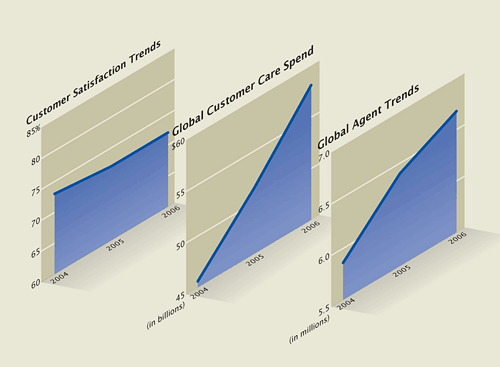|
|

article page | 1 | 2 |
Imagine, for example, that a longtime
customer of yours is being charged
her first late payment fee. You know
from experience that such customers
are likely to call in, pay up, and
request a waiver for the late fee from
a live agent. So why wait for the call?
In the future, this customer will receive
an email, text message or automated
call—before she receives the
bill—notifying her that if she
pays promptly through the company website,
no late fee will be charged. This scenario
saves the customer from frustration
and the company from an expensive call.
In the future, contact centers will
anticipate customers’ needs and
problems, improving satisfaction while
reducing costs. Which customers need
to be notified of a service outage,
a product update, or a troubleshooting
tip? A proactive contact center will
now the answer and will take action.
And with the increasing prevalence
of IP-addressable appliances, it will
become easier to locate your customers
and address their needs in real time.
Automation Effectiveness
The goal of automation is to handle
mundane tasks so that live agents are
freed up for higher-value tasks like
selling, while maintaining or even increasing
customer satisfaction. This is another
realm where making full use of the customer
information lodged in your data warehouses
is useful.
In the future, automated menus will
be highly personalized. Say you’re
the customer of a bank. After verifying
your identity, the voice response unit
will greet you by name:
“Hello, Mr. Smith, are you calling
about your CD, which is set to expire
in three days, or about your bank account,
which has a low balance that might soon
incur a fee?”
In the background, an automated program
will be monitoring the quality of this
dialogue. If there is a hitch—say,
the computer fails to understand a customer,
or the customer’s voice rises
in frustration—the program alerts
an agent. The agent can speak to the
customer directly or quickly solve the
problem from behind the scenes.
Agent Efficiency
In the
past, companies gathered data chiefly
to serve their internal purposes. Information
systems were built in functional silos
to serve one part of the business. As
a result, most customer service representatives
sit before desktops loaded with a large
number of applications—and waste
a lot of time fishing through them to
find useful nuggets of information.
In the future, information will be
organized and presented in ways that
are optimized for customers and the
front-line employees who serve them.
Agents will have access to a comprehensive
view of customer interactions over time
and across multiple channels. This holistic
view will allow agents to anticipate
and resolve issues that might otherwise
have led to future calls for help, or
to better spot opportunities for up-sell,
cross-sell, or retention efforts.
|
|
With
collaborative care, your agent will
be able to tell the customer, “Let’s
consult with the expert on that,”
rather than, “Here’s
an 800 number to call.” |
|

What’s more, the “pinball
game” will soon be over,
as customers are provided with
a single point of contact. By
leveraging the next generation
of VoIP follow-on standards such
as SIP and session containers,
a customer contact will be initiated
one time and, a collaboration
occurs among generalists and
specialists, they will each
“join” in the customer’s
contact session, where they see
the customer’s information
and actions taken by other staff
members during the session. Agents
will also “blend”
multiple channels in a single
session. For example, an agent
could “meet” a customer
on the phone, then take over
the customer’s PC and guide
the customer to a solution through
co-browsing.
This concept can be extended
to the full customer service
value chain. If your company
has partnered to deliver a service,
you will want your partner’s agents
to appear to be yours. With collaborative
care, your agent will be able
to tell the customer, “Let’s
consult with the expert on that,”
rather than, “Here’s
an 800 number to call.”
Optimizing Lifetime Customer
Value
CSPs will fail
to maximize the returns from
these improvements to customer
care unless they can tailor their
sell, service, and save efforts
to account for each customer’s
assessed anticipated lifetime
value (as well as to customer,
product and support life cycles).
This is the best way to ensure
that up-sells, cross-sells, and
the like occur in a timely and
relevant fashion.
Optimizing lifetime customer
value requires a systematic approach.
That is, it’s not enough
merely to assess a customer’s
value or even to have business
policies in place that dictate
appropriate service levels. You
also need an infrastructure that
will allow you to make sure that
those policies will be adhered
to consistently, not only through
automation but also through the
agent’s applications.
In conclusion, let’s remind
ourselves of why customer service
is important. Early adopters or
casual users of free services
may be willing to tolerate poor
service. But for CSPs aiming at
the mass market, profitability
will depend on building long-term
relationships with paying customers.
And even if adding services gives
you an edge in the short run,
in the long run, many services
will become commoditized. For
all these reasons, customer care
will make a big difference in
helping you stay ahead of the
competition.
Spending Rises, Satisfaction
Does Not
Even as spending
and hiring on customer care
continues to increase, customer
satisfaction has remained
stagnant. This “stagflation”
points to the need for a new
paradigm of customer care. (Sources:
customer satisfaction, ACSI;
customer care spend on outsourcing
and consulting services, IDC;
total agent positions in key
vertical markets, Datamonitor.)
|
|
|
 |
 |

|




